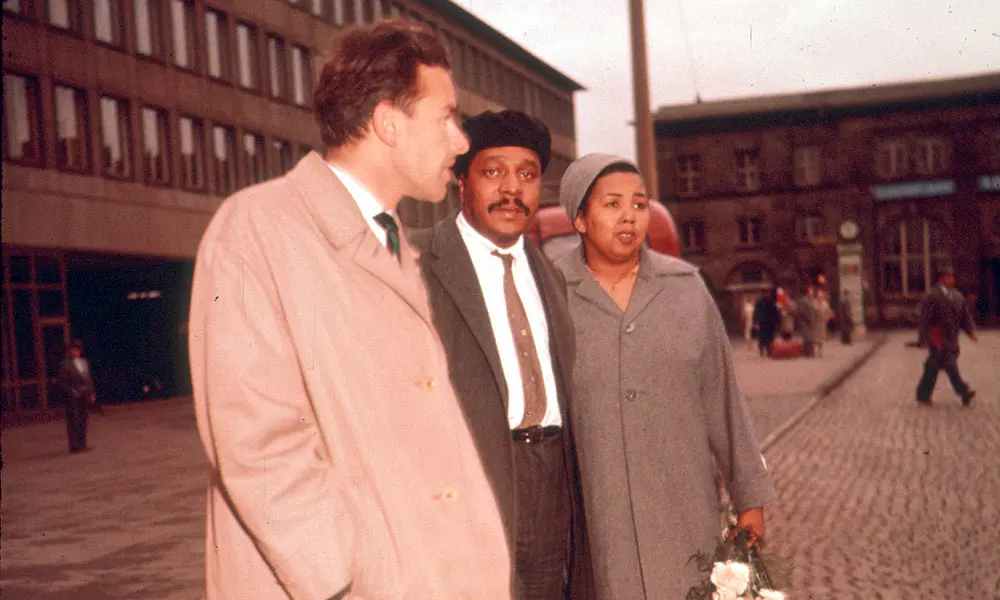
In a supernova-like burst of creative brilliance, Harlem-born pianist Bud Powell lit up the bebop jazz scene of the late 1940s, combining dazzling feats of melodic invention with harmonic ingenuity. By doing so, he not only helped to create the language of modern jazz, but also played a key role in mapping out the genre’s trajectory as it moved into the 1950s and beyond.
Many people, musicians, and critics alike, regard Powell as the piano-playing equivalent to saxophonist Charlie Parker, who together with trumpeter Dizzy Gillespie helped birth the bebop revolution in the mid-’40s, where jazz became more musically complex and was increasingly played in small group settings. Inspired by Parker’s darting alto saxophone lines, Powell helped to transform the piano’s role in jazz, liberating it from an accompanying position in the rhythm section and making it a viable frontline solo instrument.
Powell’s influence in jazz was profound. Many pianists fell under his spell, including Bill Evans, McCoy Tyner, Chick Corea, and Herbie Hancock. The latter told Downbeat magazine in 1966: “(Powell) was the foundation out of which stemmed the whole edifice of modern jazz piano.” Miles Davis, meanwhile, once wrote that Powell was “one of the greatest piano players who ever lived.”
Despite his importance in the evolution of jazz piano playing, Powell’s musical contributions are often overlooked – and sadly, his name isn’t as familiar to the general public as fellow bebop pioneers Charlie Parker, Dizzy Gillespie, and Thelonious Monk. That’s partly due to Powell’s career being a tragically short one, lasting just 17 years; from 1949, when he made his debut recording as a leader, to his death in 1966. Even so, he was prolific in the studio, recording a plethora of material for several record labels, including Mercury, Blue Note, Clef, and Verve. From those companies’ repertoires, here’s a selection of the best Bud Powell pieces that provide an introduction to his music.
Listen to the best Bud Powell pieces on Apple Music and Spotify.
Making His Mark As A Sideman
How Bud Powell evolved as a pianist can be gauged by listening to some of his early recordings as a sideman. In 1943, aged 19, he was enjoying his first noteworthy professional engagement with ex-Duke Ellington trumpeter Cootie Williams’ orchestra. He appeared on Williams’ “Floogie Boo,” contributing a short solo that showed that even as a teenager, the foundation of his unique style was already in place; even though the music is rendered in a popular big band swing style, the strong, horn-like quality of Powell’s right-hand melody offered an early indication of the pianist’s distinctive approach to soloing.
By early 1946, when bebop was in the ascendant, Powell showed that he was developing as a songwriter by co-authoring the jaunty “Dexter Rides Again” for tenor saxophonist Dexter Gordon. Characterized by zigzagging melodies, Powell’s short solo on the tune is intensely virtuosic.
The following year, Powell played with Charlie Parker alongside a young Miles Davis on a session that yielded the Parker classics, “Donna Lee,” and “Chasin’ The Bird”; on both tracks, Powell impressed with concise but densely concentrated solos packed with melodic invention.
First Solo Flight
Just as Bud Powell was making a name in the bebop world with his flamboyant style and looked certain to become a star in his own right, in November 1947 he suffered a mental breakdown and was admitted to New York’s Creedmoor State Hospital. It wasn’t the first time he had been hospitalized; in 1943, while with Cootie Williams’ band, he was so traumatized following a beating by the police for resisting arrest while drunk that he was placed in a psychiatric institution. This time, he spent eleven months in Creedmoor but after a brief spell of freedom, another breakdown led to his readmission in January 1949.
Thankfully, his confinement was short. Learning that Mercury Records wanted to record him, Powell successfully pleaded with his psychiatrist to be released for a studio session in February 1949 where he cut his first sides as a leader. Sensing that time was of the essence, he waxed a raft of 10” singles in quick succession for Mercury; they included “Tempus Fugue It,” a ferocious piece played at an insanely fast tempo that justified Powell’s nickname “Hammer Fingers” due to the forceful way he attacked the piano keys. At the same session, the less frenetic “Celia,” named after Powell’s daughter, showcased the pianist’s unique combination of flowing right-hand lines punctuated by prodding left-hand chords.
Classic Original Compositions
Later in 1949, Bud Powell joined Blue Note where he made some of his most memorable recordings. The label initially captured him fronting a quintet called Bud Powell’s Modernists that included teenage tenor saxophone sensation Sonny Rollins. They cut the infectious “Bouncing With Bud” and addictively swinging “Dance Of The Infidels,” that with their interplay between virtuosic soloists and a fluid rhythm section presaged the driving hard bop style that would dominate modern jazz in the 1950s.
Another productive Blue Note session from 1951 yielded the immortal Powell track, “Un Poco Loco”; a highly syncopated Latin-flavored number driven by drummer Max Roach’s insistent cowbell figures, it’s one of Powell’s definitive pieces. His penchant for creating blizzards of notes in the song anticipated later developments in jazz during the late 50s; namely, saxophonist John Coltrane’s “sheets of sound” approach and the febrile intensity of avant-garde pianist Cecil Taylor, who was noted for his swirling keyboard patterns. A whirlwind of notes also defines the intro to another of Powell’s signature tunes; “Parisian Thoroughfare,” a breezy, fast-swinging trio number from 1951.
Powell returned to Blue Note at the end of the 1950s to cut two albums. The second of them, 1958’s The Scene Changes, was entirely self-penned and its chief highlight was “Cleopatra’s Dream,” where bassist Paul Chambers and drummer Art Taylor laid down the perfect rhythmic accompaniment over which Powell became a font of continuously flowing melody.
Unique Interpretations Of Bebop Classics
Throughout his career, Bud Powell put an indelible spin on some of bebop’s most iconic songs. With their quicksilver piano melodies, Powell’s stunning 1949 versions of Charlie Parker’s “Ornithology” and Thelonious Monk’s “52nd Street Theme” offer vivid examples of the pianist’s absolute mastery of the keyboard.
Powell reimagined one of bebop’s most exotic numbers, Dizzy Gillespie’s “A Night In Tunisia,” as a smoldering mid-tempo groove; transforming the original’s horn lines into spectacular piano runs. Another Gillespie tune, “Be-Bop,” recorded by Powell on his 1956 trio LP, Blues In The Closet, became a vehicle for deft interplay between the pianist and bassist Ray Brown. On the same album, Powell resurrected Charlie Parker’s “Now’s The Time,” giving it a uniquely pianistic flavor.
Interestingly, Powell’s final performance with Parker was as part of a short-lived jazz supergroup called The Quintet, whose one-off concert in May 1953 in Toronto resulted in one of jazz’s greatest live albums: Jazz At Massey Hall. Also in the group were Dizzy Gillespie, bassist Charles Mingus, and Max Roach but it’s Powell who shines the brightest on jazz composer Tadd Dameron’s tune “Hot House” thanks to his lightning-fingered piano solo.
The Great American Songbook
In addition to writing his own compositions and reinterpreting bebop classics, Bud Powell had a gift for taking tunes from the Great American Songbook and remaking them in his own image. One of his favorites was “All God’s Chillun Got Rhythm,” a 1930s song originally sung by jazz chanteuse, Ivy Anderson, which he recorded in 1949. It was one of the pianist’s go-to pieces in concert; with its driving tempo and frenzied keyboard runs, it proved a glorious showcase. So too did his 1949 retooling of “Cherokee,” a 1938 Ray Noble song that was a favorite with bebop musicians (its chord changes provided a template for Charlie Parker’s classic bebop tune “Ko-Ko”). Powell’s version (which later appeared on his Verve album Jazz Giant) spotlights the sharp percussive attack of his right-hand melodies contrasting with sparse left-hand chords.
Not everything Powell played was taken at full-throttle; he often showed extreme sensitivity with ballads, but sometimes, he also used them as vehicles to demonstrate his total command of the keyboard. A quintessential example of this is his dynamic unaccompanied piano version from 1951 of the famous show tune “Over The Rainbow,” which is distinguished by a welter of cascading melodies and finespun chromatic embellishments.
“Over The Rainbow” arguably captures Powell at the pinnacle of his powers but his battles with alcoholism and mental illness during the 1950s gradually took a toll on both his health and creative powers. He moved to Paris in 1959, where he seemed happy for a time, but moved back to the States in 1963 after contracting tuberculosis; he died there in 1966, aged 41, from pneumonia. Despite his many troubles, Bud Powell seemed to find a sense of joy and freedom in music that eluded him in his personal life. He was never happier than when he was expressing himself through his beloved piano; and the memorable performances we’ve chosen here reveal his genius in all its glory.
source https://www.udiscovermusic.com/stories/best-bud-powell-pieces/

